Related Research Articles

Sir David Alexander Cecil Low was a New Zealand political cartoonist and caricaturist who lived and worked in the United Kingdom for many years. Low was a self-taught cartoonist. Born in New Zealand, he worked in his native country before migrating to Sydney in 1911, and ultimately to London (1919), where he made his career and earned fame for his Colonel Blimp depictions and his satirising of the personalities and policies of German dictator Adolf Hitler, Italian dictator Benito Mussolini, Soviet leader Joseph Stalin, and other leaders of his times.

Oscar Berger was a well-known caricaturist and cartoonist. His work appeared in numerous newspapers and magazines, and he authored and illustrated seven books. Some of the notable people who have sat for him to be drawn include: Winston Churchill, Pope Pius XII, Robert Frost, Charles de Gaulle, Marcel Marceau, Pablo Casals, Gina Lollobrigida, Christopher Morley, Bernard Shaw, Charlie Chaplin, Maria Tallchief, Ralph Richardson, Andrei Gromyko, Carlos P. Romulo, Valeska Gert, John Foster Dulles, and eight U.S. presidents.

José Guadalupe Posada Aguilar was a Mexican political printmaker who used relief printing to produce popular illustrations. His work has influenced numerous Latin American artists and cartoonists because of its satirical acuteness and social engagement. He used skulls, calaveras, and bones to convey political and cultural critiques. Among his most enduring works is La Calavera Catrina.
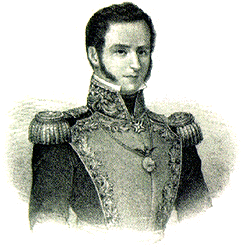
José María de Tornel y Mendívil (1795–1853) was a 19th-century creole Mexican army general and politician who greatly influenced Mexico’s political stage and the career of President Antonio López de Santa Anna.
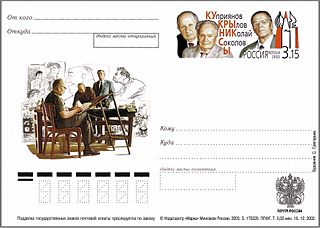
The Kukryniksy were three caricaturists/cartoonists in the USSR with a recognizable style.
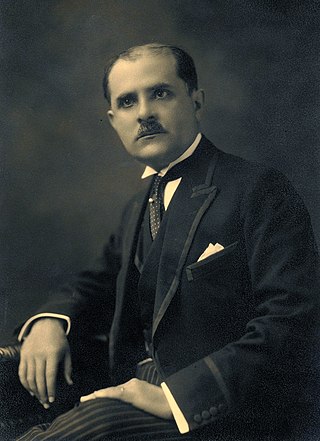
Luis Antonio Eguiguren Escudero was a Peruvian educator, magistrate, historian and politician. He was the director of the General Archive (File) of the Nation (1914), Alderman of Lima (1914–1920), Mayor of Lima (1930), President of the Constituent Congress (1930–1932), founder and leader of the Peruvian Social Democratic Party. He won the Peruvian presidential election of 1936, but his victory was ignored by the Congress and the then-President Oscar R. Benavides, who claimed that he had won with votes of the APRA. He presided over the Supreme Court and the Judiciary in 1953 and 1954.
Clive Uptton was a widely regarded British illustrator and painter of landscapes and portraits.
Donato Guerra is one of 125 municipalities in the State of Mexico, Mexico. It's municipal seat is the town of Villa Donato Guerra, which is the 13th largest town in the municipality of Donato Guerra. The area is also known as Malacatepec and La Asunción Malacatepec. (Villa) Donato Guerra is located in the western part of the State of Mexico. In the region that is identified with Valle de Bravo. The town was named in 1880 in honor of Donato Guerra, a distinguished soldier of the War of La Reforma. It is located around 77 kilometers from Toluca which is the capital of the state, on Federal Highway number 35 Mexico City - Zitácuaro.

John Moors Cabot was an American diplomat and U.S. Ambassador to five nations during the Truman, Eisenhower, and Kennedy administrations. He also served as Assistant Secretary of State for Inter-American Affairs. He warned repeatedly of the dangers of Soviet communism toward American interests in Latin America.

Viktor Nikolaevich Denisov, best known by the shortened pseudonym Viktor Deni, was a Russian and Soviet satirist, cartoonist and poster artist. Deni was one of the major agitprop poster artists of the Bolshevist period (1917–1921).

Carmelo Filardi (1900–1989) was a Puerto Rican artist of Italian ancestry, was a cartoonists who had his work published in Puerto Rico's El Mundo newspaper starting in 1927. He was from Yauco, Puerto Rico and his parents were born in Italy. Filardi specialized in satire and journalistic criticism. To do this, he used depictions of average daily life in Puerto Rico to illustrate his thoughts. He was a caricaturist and his work is included in University of Puerto Rico collections.
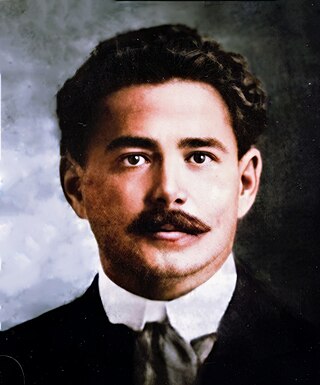
Antonio Irineo Villarreal González was a Mexican politician and soldier.
The Fifth Regiment was an elite corps loyal to the Spanish Republic at the onset of the Spanish Civil War. Made up of volunteers, the Fifth Regiment was active in the first critical phase of the war and became one of the most renowned units loyal to the Republic.
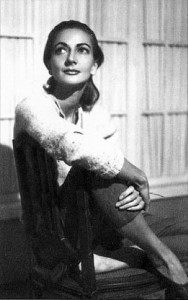
María Luisa Elío Bernal was a Spanish writer and actress exiled in Mexico. She wrote two books and the script of the award-winning autobiographical film El balcón vacío, which was the first film to depict the lives of Spanish exiles during the Spanish Civil War. She also performed on Mexican television and Mexican films. Elío was involved in several cultural and literary circles. She was also an inspiration for Gabriel García Márquez. His masterwork One Hundred Years of Solitude was dedicated to Elío and her husband.

Siempre! is a news and political magazine published in Mexico. The magazine is published on a weekly basis. By the end of the 1960s the magazine became a significant part of Mexican politics and an important publication for democratization of the country.

The Council of the Hispanidad was a public body of the Francoist dictatorship dependent of the Spanish Ministry of Foreign Affairs. Created in 1940, it aimed towards the realization of the idea of "Hispanidad". It lasted until 1945, when it was replaced by the Institute of Hispanic Culture (ICH).

Pedro Xavier Molina Blandón is a Nicaraguan political cartoonist who has worked for the news outlet Confidencial.

Novyi Satirikon was a Russian language weekly humor and satirical magazine that was published in Saint Petersburg in the period 1908–1914. During the 1917 Revolution, the magazine held an anti-Bolshevik political stance, and most of its contributors had to flee Russia after the magazine was closed in 1918.
Sylvia de Arruda Botelho Bittencourt, also known as Majoy, was a Brazilian journalist who worked as a war correspondent in Europe during World War II. In 1941, she became the first woman to receive the Maria Moors Cabot Prize.
References
- ↑ "ANTONIO BERNAL, CARTOONIST, DIES; Mexican Caricaturist, Noted as a Foe of Dictatorships, Won Cabot Award in '52". New York Times. January 1, 1961.
- ↑ "Album historico la II guerra mundial ilustrada por Arias Bernal". Library of Congress. Retrieved 2020-01-17.
- ↑ Dancis, Daniel (September 26, 2017). "Arias Bernal's Trip to Washington". National Archives Pieces of History Blog.
- ↑ Daniel (2017-09-26). ""Arias Bernal's Trip to Washington": a Mexican Cartoonist Joins the War Effort". The Text Message. Retrieved 2020-01-17.
- ↑ "Maria Moors Cabot Prizes". www.journalism.columbia.edu/cabot.
- ↑ "Past Maria Moors Cabot Winners" (PDF). 2016-10-19.